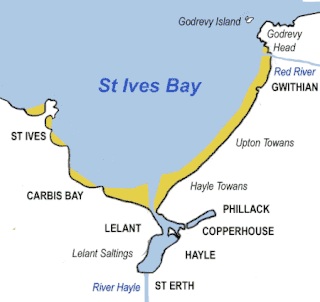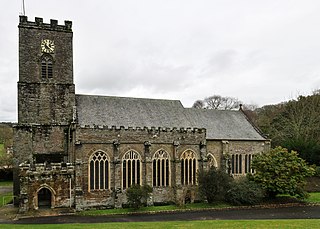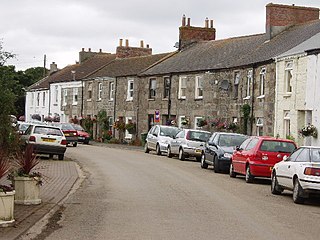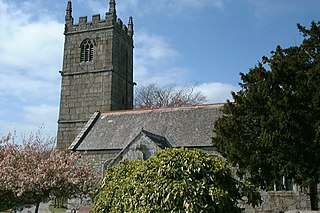Related Research Articles
Lyonesse is a kingdom which, according to legend, consisted of a long strand of land stretching from Land's End at the southwestern tip of Cornwall, England, to what is now the Isles of Scilly in the Celtic Sea portion of the Atlantic Ocean. It was considered lost after being swallowed by the ocean in a single night. The people of Lyonesse were said to live in fair towns, with over 140 churches, and work in fertile, low-lying plains. Lyonesse's most significant attraction was a castle-like cathedral that was presumably built on top of what is now the Seven Stones Reef between Land's End and the Isles of Scilly, some 18 miles (29 km) west of Land's End and 8 miles (13 km) north-east of the Isles of Scilly. It is sometimes spelled Lionesse.

St Michael's Mount is a tidal island in Mount's Bay near Penzance, Cornwall, England. The island is a civil parish and is linked to the town of Marazion by a causeway of granite setts, passable between mid-tide and low water. It is managed by the National Trust, and the castle and chapel have been the home of the St Aubyn family since around 1650.

Petroc or Petrock was a British prince and Christian saint.

Godrevy is an area on the eastern side of St Ives Bay, west Cornwall, England, United Kingdom, which faces the Atlantic Ocean. It is popular with both the surfing community and walkers. It is part owned by the National Trust, and offshore on Godrevy Island is a lighthouse maintained by Trinity House which is said to be the inspiration for Virginia Woolf's novel To the Lighthouse. Godrevy lies within the Cornwall Area of Outstanding Natural Beauty (AONB) and the South West Coast Path runs around the whole promontory. There are several public car parks on the western side where the National Trust owns and operates a café.
Breage or Breaca is a saint venerated in Cornwall and South West England. According to her late hagiography, she was an Irish nun of the 5th or 6th century who founded a church in Cornwall. The village and civil parish of Breage in Cornwall are named after her, and the local Breage Parish Church is dedicated to her. She is a saint in the Eastern Orthodox Church and Catholic Church.

Hayle is a port town and civil parish in west Cornwall, England, United Kingdom. It is situated at the mouth of the Hayle River and is approximately seven miles (11 km) northeast of Penzance.
West Penwith Rural District was a rural district in Cornwall, England, United Kingdom, from 1894 to 1974. It was enlarged in 1934 by the abolition of Hayle, Ludgvan, Madron, Paul, and Phillack urban districts, and also took in part of the disbanded Redruth Rural District.

Mount St Gwinear is a mountain in Victoria, Australia, located at the north-east end of the Baw Baw National Park in the Gippsland high country. It is popular with families looking for a cheap and accessible snow-play/tobogganing destination and cross-country skiers. The Baw Baw Plateau provides an abundance of easy touring terrain. Mount Baw Baw downhill ski village is approximately 9 km away across the Baw Baw plateau to the south-west and trails link the resorts.

Gwinear, Guigner, was a Celtic martyr, one of only two early Cornish saints whose biographies survived the Reformation. The Life of Gwinear was written in the early 14th century by a priest named Anselm, and has sometimes been printed among the works of Anselm of Canterbury. His feast day is March 23.

Phillack is a village now in the parish of Hayle, in west Cornwall, England. It is about one mile (1.6 km) northeast of Hayle and half-a-mile (0.8 km) inland from St Ives Bay on Cornwall's Atlantic Ocean coast. The village is separated from the sea by a range of high sand dunes known as The Towans.

Ia of Cornwall was an evangelist and martyr of the 5th or 6th centuries, flourishing in the area of St Ives, Cornwall. She is said to have been an Irish princess, the sister of Erc of Slane.

Felicitas of Rome, also anglicized as Felicity, is a saint numbered among the Christian martyrs. Apart from her name, the only thing known for certain about this martyr is that she was buried in the Cemetery of Maximus, on the Via Salaria on a 23 November. However, a legend presents her as the mother of the seven martyrs whose feast is celebrated on 10 July. The Eastern Orthodox Church celebrates their martyrdom on 25 January.

Cornish mythology is the folk tradition and mythology of the Cornish people. It consists partly of folk traditions developed in Cornwall and partly of traditions developed by Britons elsewhere before the end of the first millennium, often shared with those of the Breton and Welsh peoples. Some of this contains remnants of the mythology of pre-Christian Britain.

Christianity in Cornwall began in the 4th or 5th century AD when Western Christianity was introduced as in the rest of Roman Britain. Over time it became the official religion, superseding previous Celtic and Roman practices. Early Christianity in Cornwall was spread largely by the saints, including Saint Piran, the patron of the county. Cornwall, like other parts of Britain, is sometimes associated with the distinct collection of practices known as Celtic Christianity but was always in communion with the wider Catholic Church. The Cornish saints are commemorated in legends, churches and placenames.

Gwinear is a small village and former civil parish, now in the parish of Gwinear-Gwithian, in the Cornwall district, in west Cornwall, England, UK. It is about two miles (3 km) east of Hayle and overlooks the Angarrack valley. In 1931 the parish had a population of 1234. On 1 April 1934 the parish was abolished to form "Gwinear Gwithian".

St Erth’s Church, St Erth, is a Grade I listed parish church in the Church of England Diocese of Truro in St Erth, Cornwall, England, UK.

St Gwinear's Church, Gwinear is a Grade I listed church in the Church of England in Gwinear, Cornwall.

St Gothian's Church, Gwithian is a Grade II* listed parish church in the Church of England Diocese of Truro in Gwithian, Cornwall, England, UK. Nothing is known about St Gothian, Gocianus or Gwithian.

St Elwyn’s Church is a Grade II* listed parish church in the Church of England Diocese of Truro in Hayle, Cornwall, England, UK.

St Felicitas and St Piala’s Church, Phillack is a Grade II* listed parish church in the Church of England Diocese of Truro in Phillack, Cornwall, England, UK.